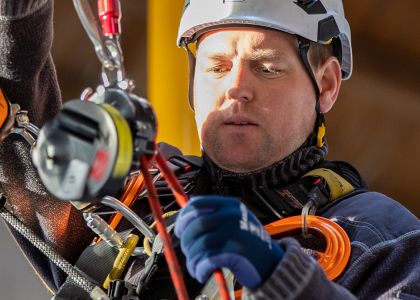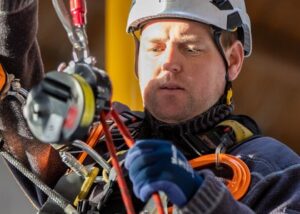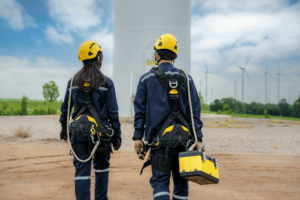GWO training providers are increasing in number rapidly. But GWO certification is just the start?
GWO (Global Wind Organisation) certification refers to a set of standardized training programs and certificates designed for professionals working in the wind energy industry. The certification is provided by the Global Wind Organisation, an industry-led body established by wind turbine manufacturers and owners to ensure a safe work environment and set a global standard for safety and technical training. Numerous training and education companies provide GWO Training Courses that meet the training standards, STL USA is one such provider.
Key Components of GWO Certification:
- Basic Safety Training (BST):
- First Aid: Training in emergency response and first aid specific to the wind industry.
- Manual Handling: Techniques for safe manual handling of loads to prevent injuries.
- Fire Awareness: Training to handle fire-related incidents and use firefighting equipment.
- Working at Heights: Safety measures and practices for working at heights, including use of fall protection equipment.
- Sea Survival: (Optional) Training for offshore wind turbine technicians, covering survival at sea and transfer techniques.
- Basic Technical Training (BTT):
- Covers bolt tightening, mechanical, electrical, and hydraulic systems in wind turbines.
- Aimed at technicians who are new to the wind industry and need to understand the technical aspects of wind turbines.
- Advanced Rescue Training (ART):
- More specialized safety training for those who need advanced knowledge and skills.
- Includes modules like hub and nacelle rescue and signgle rescuer options
Purpose and Benefits:
- Safety: Ensures that all personnel working in the wind industry are trained to a high safety standard, reducing the risk of accidents and injuries.
- Standardization: Provides a consistent training standard recognized globally, facilitating easier mobility of workers across different projects and regions.
- Compliance: Helps companies comply with regulatory and safety requirements in various countries.
- Efficiency: Improves the efficiency and effectiveness of wind energy projects by ensuring that workers are well-prepared for the technical and safety challenges they might face.
GWO certification is highly regarded in the wind energy sector and is often a prerequisite for employment in various roles within the industry.
While GWO accreditation is highly valuable and essential for working safely in the wind energy industry, it is not sufficient on its own for a few reasons. Additional training, certifications, and skills are often required to fully prepare individuals for the complexities of working on wind turbines. Here’s why:
1. Technical Expertise:
- Specialized Skills: Working on wind turbines requires specific technical knowledge and skills that go beyond basic safety and technical training. This includes understanding the mechanical, electrical, and hydraulic systems unique to different turbine models.
- Manufacturer-Specific Training: Many turbine manufacturers provide specialized training for their specific models, which is necessary to understand the nuances and proprietary technology of their equipment.
2. Experience and Practical Training:
- Hands-On Experience: GWO training includes practical components, but actual field experience is crucial for developing the proficiency needed to handle real-world scenarios and unexpected issues that may arise during maintenance and repair work.
- On-the-Job Training: Working under the supervision of experienced technicians and engineers helps new workers apply their training in real-world settings, which is critical for building competence and confidence.
3. Advanced and Specialized Certifications:
- Further Certifications: There are additional certifications and training programs beyond GWO that may be required, such as high voltage safety, rope access techniques (IRATA/SPRAT), and advanced rescue operations.
- Professional Licenses: In some regions, specific professional licenses or certifications may be required to perform certain tasks or to comply with local regulations.
4. Regulatory and Company-Specific Requirements:
- Compliance with Local Regulations: Different countries and regions may have their own safety and technical training requirements that go beyond GWO standards. Workers need to be aware of and comply with these local regulations.
- Company-Specific Training: Individual companies may have their own training programs and safety protocols that workers need to follow, which can include company-specific emergency procedures, operational guidelines, and additional safety measures.
5. Continuing Education and Skill Development:
- Ongoing Learning: The wind energy industry is constantly evolving, with new technologies and best practices emerging regularly. Continuous professional development and staying updated with the latest advancements are crucial.
- Advanced Technical Skills: As technology evolves, workers may need to acquire advanced technical skills, such as familiarity with SCADA systems, data analysis, and remote monitoring technologies.
6. Soft Skills and Team Coordination:
- Communication Skills: Effective communication is essential for coordinating with team members, especially in complex and potentially hazardous environments.
- Problem-Solving and Decision-Making: Working on wind turbines often requires quick thinking and problem-solving abilities to address unexpected challenges safely and efficiently.
7. Health and Fitness:
- Physical Demands: The job can be physically demanding, requiring a good level of fitness and the ability to work at heights and in various weather conditions. Regular health and fitness assessments may be necessary to ensure workers can meet these demands safely.
In conclusion, while GWO accreditation provides a critical foundation in safety and basic technical skills, it must be complemented by additional training, experience, certifications, and compliance with local regulations and company-specific requirements to fully prepare individuals for the comprehensive demands of working on wind turbines.
Here’s STL USA’s Training Manager, Brandon McKelvain’s view on the current landscape around GWO accreditations –
“The strength of the GWO accreditations is in basic safety and rescue training. The standards are laid out in a simple consistent method. The Taxonomy Framework is excellent for developing content and courses. The “generic approach” found in GWO standards is very effective for introducing participants to a verity of PPE and rescue kits.
However, the depth of basic technical is insufficient and the certification being enduring presents a problem for improvements. More advanced technical knowledge, skills, and abilities are essential for wind technicians before entering the field and unfortunately this isn’t happening.
In addition to GWO accreditations, I think the ACP’s Micro Credentials are an excellent step in the right direction. We’ve made it a point to start integrating these into our training courses. In doing so, technicians know how to apply their skills, which is essential for technicians.”
Interested in learning more about our courses?
Click the button to learn more



